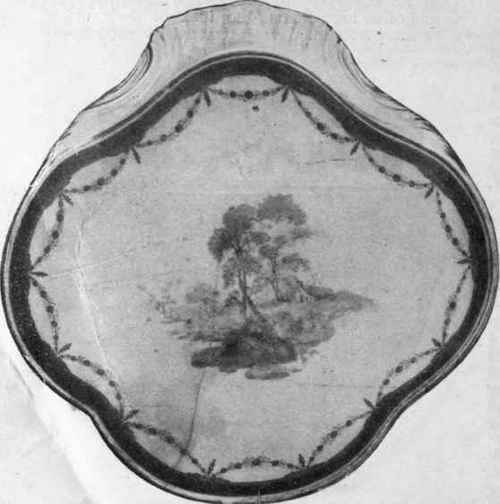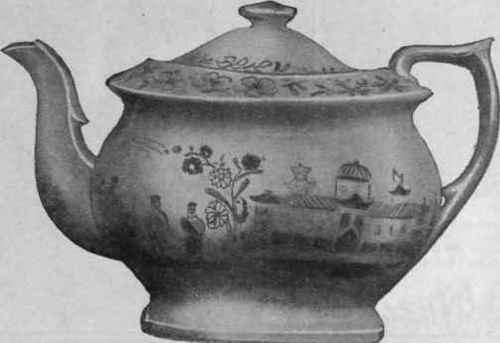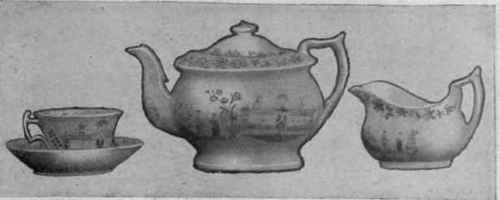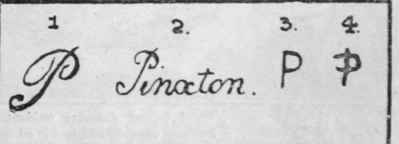Pinxton, Mansfield, And Torksey Porcelains. Continued
Description
This section is from "Every Woman's Encyclopaedia". Also available from Amazon: Every Woman's Encyclopaedia.
Pinxton, Mansfield, And Torksey Porcelains. Continued
The Derby Cornflower
The same flower was used also at Derby, as already has been shown (page 1664, Vol. 3). The Derby cornflower, however, is smaller in size than that used at Pinx-ton, the whole effect being neater.
Another design will be seen in the second illustration. This plate has also a blue edge, and is decorated with a wreath of green leaves, shaded with brown and with sprays of small blue berries on fine red stalks. In the centre is a spray of similar berries. "In the South Kens-

Fruit-dish or Pinxton porcelain, painted in colours, it is supposed, by John Cutts, and decorated with gilding From the South Kensington Museum ington Museum may be seen a goblet of Pinxton porcelain, shaped like a chalice, and eight inches high. This is a very uncommon piece, and is decorated with a large spray of cornflowers and foliage on either side in natural colours ; it has an edging of blue.
Upon more decorative pieces a canary - coloured ground was popular, and a very beautiful ice-pail, which may be seen at South Kensington, has this background ornamented with scrolls of fine gilding, and with a frieze of exquisitely painted roses and other flowers and foliage. These flowers, it seems certain, were painted by William Billingsley.
The Work Of John Cutts
In spite of this man's fame as a flower painter, the Pinxton factory is more noted for its landscape than for its flower painting. Some of the landscapes were of a sketchy character, but many of them are distinguished by the excellence of their colour and drawing. They are sometimes found in monochrome, and were painted either on a whole white background, or upon white panels surrounded by gilding upon a canary background. With this kind of decoration gold was lavishly used as edges, borders, and scrolls. The name of the landscape was generally inscribed either under the painting or beneath the piece at the bottom.
John Cutts was the principal painter at Pinxton ; he was famous for the rapidity with which he ac-comp1ished his work, which has been described as "magical." A dessert-dish, supposed to have been painted by this artist, may be seen amongst the illustrations. In the centre is a landscape in colours and it is bordered with a wide band of rich vermilion red, with looped festoons of gold.
The mark upon the Pinxton porcelain is generally the letter P, sometimes in script, also the word Pinxton, and a number. The letters N.p. are rare marks; they are generally painted in red over glaze, but sometimes occur in blue. A great deal of the porcelain made at this factory was unmarked.
As we have seen, Billingsley left Pinxton in 1800, but until 1812 china of a somewhat coarser description continued to be made.
"Mr. Coke's Coin"
The workmen at this factory were paid in china tokens, round flat pieces of china upon which the sum represented was marked. They passed current round and about Pinxton, where they were known as " Mr. Coke's Coin."
We have no authentic specimens of Staffordshire porcelain decorated by William Billingsley during his short sojourn at Mansfield, though we know that this was his means of livelihood during his stay there.
At Torksey in Lincolnshire, he established a manufactory of his own, but in order to do this was obliged to mortgage the property. He soon got into financial straits, and as in those days a debtor could be locked up at sight, he deemed it wise to disappear.
Billingsley has been much blamed for taking this course, and writers have spoken of him as a man without conscience or morals. Mr. Turner, who has given such a full and interesting account of this wonderful potter artist, does not take this view ; he says, " He was a man with an ideal, and for the sake of it would run any risk."
At Torksey, for eight years, the beautiful glassy porcelain which he had brought to perfection at Pinxton, was made by Billingsley, and it seems that he devoted his whole attention to the body, and did not attempt himself to decorate his wares.
This porcelain is now very rare, but as there it bears no distinguishing mark, and as few writers and collectors have interested them-

The teapot of the service, showing in detail the beautiful ornamentation employed
From Mr, W. F. Snell's collection

A beautiful Torksey tea service, decorated with colours in Chinese taste. This porcelain is now very rare
From Mr. W. F. Snell's collection selves in the factory, it is more than possible that many pieces exist in our eastern counties which have not been identified.
The body of this very interesting china is identical with that of Pinxton in its extreme fineness and translucence, but the decoration is poor. It generally takes the form of Chinese pagodas, flowers, and figures, or of symbolic or classical figures, with landscape backgrounds. These are somewhat crudely painted by inferior artists, and quite unworthy of the beautiful body upon which they appear.
The shapes used for tea services were those in vogue in Staffordshire in the early days of the nineteenth century, but the body is finer than any made in the Potteries at that time.
The delightful Torksey tea service which is illustrated has an authentic history covering the hundred years of its existence, having been in the possession of only two families during this period. It is of beautiful quality, and is decorated in Chinese style. The floral borders are painted in blue, pink, yellow, white, and vermilion, with green foliage. The pagoda .is in yellow, blue, vermilion, and brown ; the fence is in blue and red; the shadows cast by the building are blue, and the clouds are grey. The figures apparently are those of some potentate with attendants.

Marks found upon Pinxton porcelain. The most commonly found mark is the letter P. Many specimens are unmarked
Continue to:


